Home page: www.treks.org
Table of Contents "On the road
to Kabul and other short stories of treks"
Pilgrimage to Muktinat
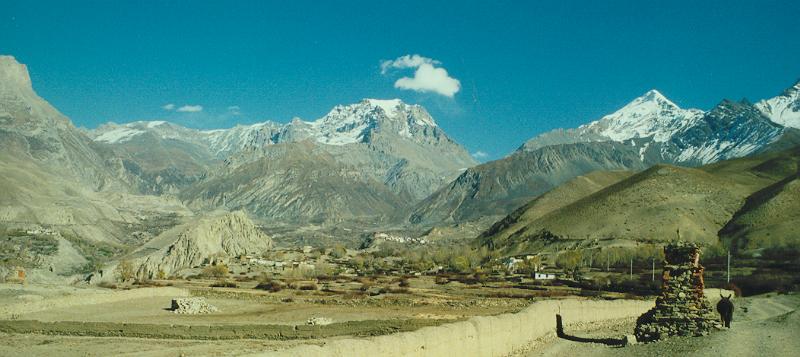
View at Muktinat (centre, far distance) at the foot of the Thorong La
pass (centre, between two high mountains).
“Two lost
souls in the riverbed, two clean souls in the riverbed, ....”, I was singing
silently as we walked the last hour back to Jomson against a fierce dry wind,
my face protected by a scarf and jacket hood. We returned from a two day trip
to Muktinat, a famous Hindu pilgrimage place in the mountains of the Mustang
Region close to Tibet. In the far distance in the barren river valley, I could
see the two friends of Dorjé Sherpa following us.
To Muktinat
After doing
the Daulaghiri Round Trek in only two weeks and crossing two passes of 5400 and
5l00 m, we still had two more days in Jomson. This is on the edge of the
famous Mustang area, a dry area en route to Tibet from Pokhara.
Culturally, Mustang resembles Dolpo, the isolated region to the West high up in
the mountains, but is easier accessible. The people of Mustang and Dolpo are
both of Tibetan origin.
Muktinat,
the famous Hindu pilgrimage place with the 102 water taps at the base of the
Thorung La Pass at 3600 m, would be the best choice for a two day trip to spent
the spare days. Dorjé Sherpa was keen to be our guide and it took a bit of
persistence plus a call to Tendy on the satellite phone, our expedition
outfitter, to take him along.
Dorjé was
extremely happy he could come along and insisted he should carry my backpack.
After spending a week above 3600 m in Daulaghiri, Henny and I were extremely
fit and we had a high pace. This was needed as it would be a long day, normally
done in 1.5 days.

Past Jomson the true
Mustang Desert starts and the people live of a barren and cold land just like
in Tibet. This area is the start of the rain shadow, the high mountain ranges of
Dhaulagiri [1] and Anapurna [1]
blocking the warm, moist weather from the South.
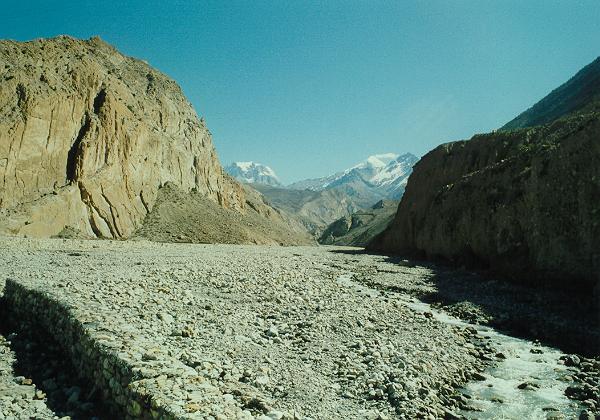
The first
two hours we walked in the broad river bed surrounded by barren, high
mountains.
We passed few houses and a
single small apple orchard but for the rest it was all rocks and gravel with
little vegetation. Higher up, in the distance you could see small villages
surrounded by the only green fields on
sparse flat areas. After two hours we reached a small tourist settlement with a
few simple restaurants and hotels for Hindu pilgrims and Western tourists.
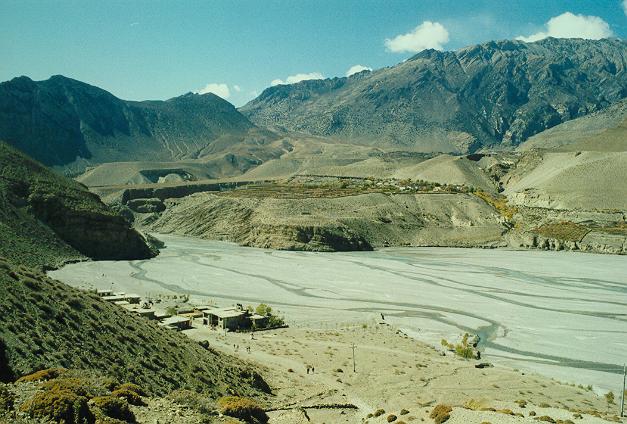
This is the half way point,
from here it goes up, from 2900 to 3600 m. The dry daily afternoon wind already
started to pick up during lunch on the restaurant terrace.
After lunch
we went up, getting a nice view of the area.
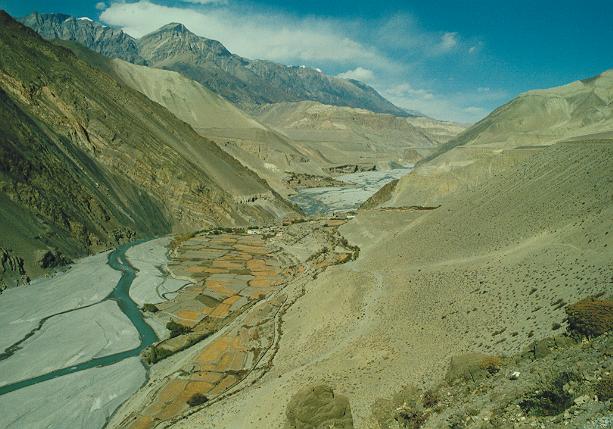
View North along the main river bed.
We met
Hindu pilgrims regularly returning from Muktinat. After one hour we had a view
at Muktinat and the Thorong La Pass of the Anapurna Round but it would still
take three hours of going up slowly before we finally arrived, having a
constant view at the village and Thorung La pass, feeling much closer than they
were [1].
The
neighboring villages were still original [1] except
for the apple trees and electricity, but Muktinat was disappointing, mainly
consisting of recent hotels for white tourists and Hindu pilgrims.
Muktinat
Here we met
the French and Italian runners again we first saw in Marpha near Jomson, 2 days
ago. They participated in a 23 day run from Anapurna Base Camp to Everest Base
Camp, total distance around 1000 km (?), 38 km up, 37 km down, See Website [1]. Tomorrow they would cross the 5400 m high Torung La pass and today was a
day off, also for a medical chech-up.
An Italian
runner sitting outside in the cool afternoon sun took 4.5 hours from Marpha, we
did this in 6 hours but with two stops. I told him this in French as he did not
speak English but he did not react and tried to stop the conversation.
The
contrast between the female runners walking around in tights and the local
women was enormous, not just the dress, no, more their activities,
participating in a sponsored mountain run in a country were the average income
is 1 dollar a day. I got mixed feelings.
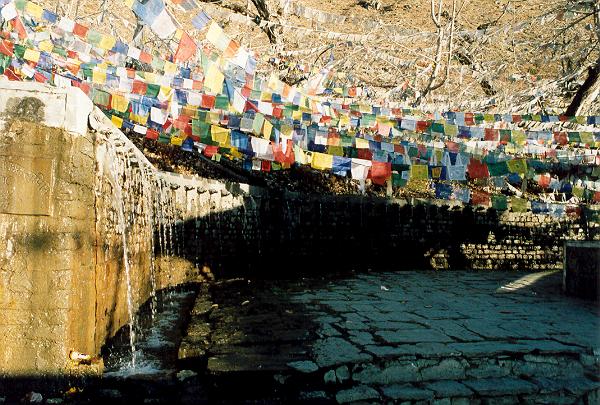
Temple
with 102 taps.
At 5 PM we finally
arrived at the temple and I pulled out my bathing shorts to take a cleansing
bath, the idea that you walk in the fountain and get sprayed by each tap to
clean your body and soul completely.
On testing
the water temperature I got second
thoughts, especially when I saw ice on the edge of the fountains, and the water
was near freezing. I decided to “clean” my left hand only to stimulate the full
healing of the sprained wrist which was
still sensitive and to clean this dirty hand. I barely made it till the end
nearly slipping on the ice and the hand was very cold.
An old man
and woman did the same, also cleaning the dirty left hand, the hand used for
dirty things like a toilet. Now they would be ready for a reincarnation.
At sunset
it got cold and the streets were deserted. Being November, the temperature dropped
to -10 Celsius this night. In the hotel
Dorjé met two friends from Kathmandu, a young couple, Anil and xxxxx.
Back to Jomson
Going down
to the half way point was easy, also because the head wind did not start until
noon.
We walked
along with Dorjé’s friends who tried and managed to keep up with our fast
pace.
Past the
big hanging bridge we lost shelter and now the wind was howling through the
valley.
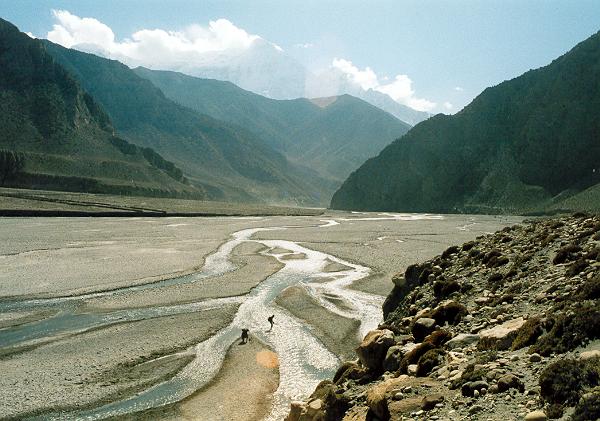
The two
friends toke a wrong turn and had to wade through the stream.
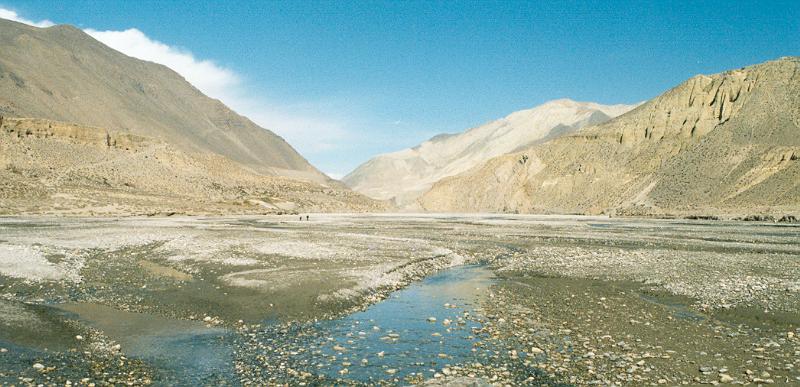
At the last narrow part,
they were a km behind.
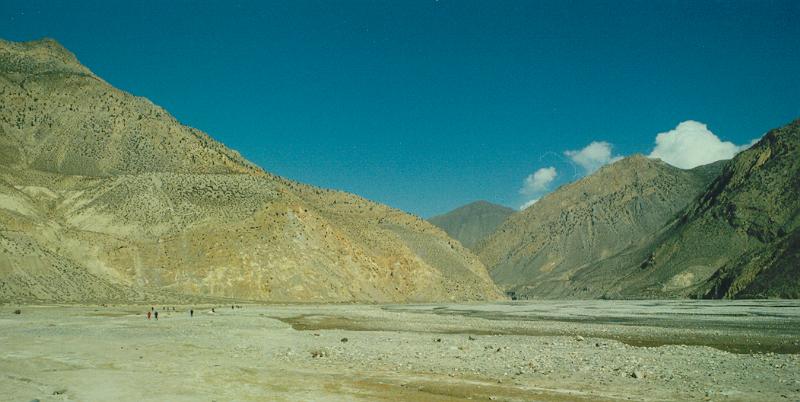
Passing the cliff in a
narrow part, now in the open wide riverbed the storm-force wind hit us full.
“Two lost
souls in the riverbed, two clean souls in the riverbed, ....”, it sat in my
head for the last hour back to Jomson. The wind was fierce and dry. My face
protected by a scarf and jacket hood, still my I could barely look ahead, the
strong wind making my eyes to tear and the noise was loud. One more hour to go.